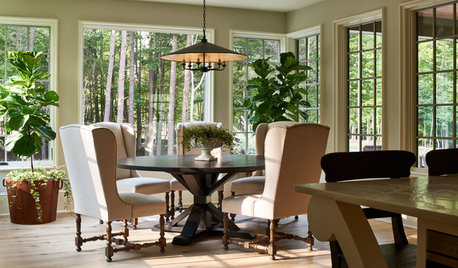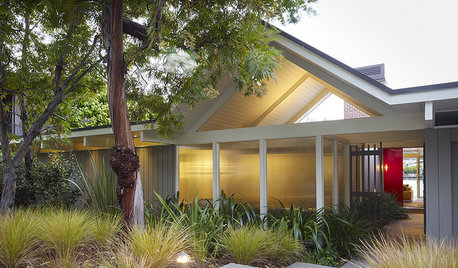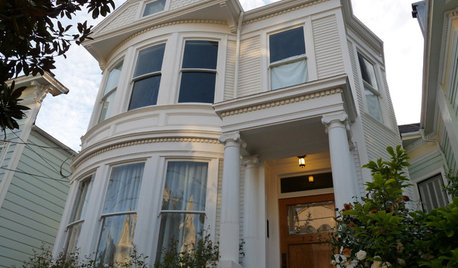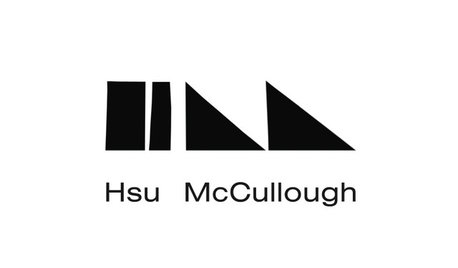North American vs European rose hybridisers
cactusjoe1
16 years ago
Featured Answer
Sort by:Oldest
Comments (50)
jim_w_ny
16 years agognabonnand
16 years agoRelated Discussions
Cant's tea roses
Comments (17)I expect we could....if we could find any. The real shocker is that there is 1 (yes just 1) grower selling tea roses in the UK - Peter Beales. The wildly encouraging thing is that his nursery is less than 6 miles from my wood! A mere bicycle ride. The less encouraging part is the wood itself - although the southern edge is clear across water meadows, woodland is not a natural home for tea roses. With Peter Beale's death earlier this year, the propagation of teas is on an extremely fragile footing. I suspect they do have a few devotees, especially in the southern counties....but I also believe that it was stubborness and a deeply personal decision of Mr.Beales to grow these roses - hope his daughter will be continuing. The slender handful of growers who do deal in old roses grow almost exclusively once flowering Europeans and a handful of bourbons..... although many people in the UK conflate old roses with ramblers and climbers - we are quite comfortable with Albertine, Madame Alfred, and the trove of enormous white ramblers such as Wedding Day and Bobbie James. There has been an increasing interest in heirloom seeds (on both sides of the atlantic) but has tended to translate into a search for fruits and vegetables while flowers and shrubs are relegated to the second division. I tend to sit on the fence a bit since I grow a mix of open pollinated veggies (mainly so I can save the seeds) but also swear by some of the F1 varieties (for the health and vigour which is inbuilt) - yes, the taste of an heirloom tomato is nice...but no use at all if the row has gone down to blight. Moreover, while the fuss about organics rattles on: I have come to believe that there is NO difference in the organic-ness of a vegetable (taste-wise) - it is in the cultivation and the freshness where we get the real joy of growing your own....although there are big caveats when comparing home grown anything against intensive agriculture of monocrops. Back to teas (it is hard to stick to the point, discussing horticulture since there are so many overlaps), I feel compelled to attempt at least one variety - a visit to Attleborough in June may well decide which one to choose as I would really be cross with myself if I lost the chance because of dithering (and yep, have been here before, pondering a tea to try, but bottled it at the last minute and bought another Hebe's Lip instead (for some reason, I was really hopeless striking cuttings on that one)....See MoreRegarding 'The American Rose Society Book Of Roses'
Comments (54)Here are some others not to forget: Griffeth Buck Vernon Rickard Paul Barden I don't believe Americans are dissinterested in things that were not invented here. We seem to be quite fond of things with European names like Krupps, Braun, and all those other coffee makers. We eat tons of ethnic food. Lots of us are tourists. When the Beatles came out many of us became Anglophiles and a lot of us still think the English cottage garden is the ultimate. We are a country full of appreciative people, IMO. I have never noticed anyone not wanting to buy a rose because it was bred by a non-AMerican. Excuse me for digressing. Anyway even with it's flaws I bet I could really enjoy looking at that book, Devon. I usually check the big Botanica's out from the library but have my easy to hold paperback copy which I enjoy. My library also has The Rose Bible and Antique Roses for the South, both of which were responsible for a number of roses in my garden. Linda...See MoreEuropean style home construction in USA?
Comments (11)Masonry walls can be built of concrete (poured in place or precast from a factory), unit masonry (bricks and blocks), or concrete poured into insulated factory made forms. Any of these structural wall systems can be covered with a thick coating of cement plaster called stucco that is very common in Europe. (from Old High German stucki & German Stück). Synthetic stucco (EIFS) also originated in Europe long before it came to the US. You are on the "Building a Home" forum. No one here wants to just build a house although many may adopt builder jargon like "my build" perhaps to sound more knowledgable but I would never use it with a client. You should also consider that the choice of structural materials is a often a cultural, economic or severe climate issue. You should also understand that wood is a renewable resource although regulation of cutting is necessary for that to happen. this is not a simple issue. There would be fewer people in the Pacific Northwest if there were no logging industry. I have worked for an architectural firm in Geneva and visited many friends homes in France. What has been immediately noticeable is the lack of space in their homes especially in the bathrooms and kitchens. In one side by side duplex home with garages at either end, I was able to stand in one garage and hear a conversation in the other one though the hollow cores of the second floor precast concrete slab system. I find it is more expensive to build many desirable features into an all masonry house. Wide windows are an example. Europeans, like many of my professors in architecture school, like tall narrow windows that limit exterior views and decrease privacy. Most Americans like wide windows in order to take advantage of exterior views or even when there is no view and privacy is not negotiable. Wide windows in masonry requires expensive steel or composite beams. Thats not a problem in Europe because it is cheaper than imported engineered lumber that is so prevalent here. Nor is concrete usually considered a good finish material because it is cold to the touch and is difficult to finish well. Covering masonry walls adds cost and loses floor area. The US has a wide variety of climates and in many regions energy conservation is not only desired but mandatory. Masonry has some good energy conservation features but it is not a good insulator and adding surface insulation adds cost and loses floor area. The additional cost of this kind of construction could probably only be recouped in a severe wind region like the coast of Florida. You should be aware that the Pacific Northwest is a severe climate zone for rainfall. This is not a good climate for stucco or any wall without a secondary drainage system, in fact, I believe it is require by code now. A better masonry system would be a brick veneer cavity wall system with concrete block (CMU) or wood/metal studs as the structural wall. Incidentally, residential building codes all contain requirements for not only wood framing but for light metal framing. It is possible to build a conventionally framed home for light steel and fiberglass faced gypsum wall sheathing. I suppose the floors sheathing would still be wood. The conservation of wood is not a viable reason to build with masonry. I caution you about justifying the design of your home in the interest of your children. You should not assume that they will want to live in this house or that their jobs and marriages will not take them elsewhere. I have worked for many people who have bought a house from retirees who were moving in order to be closer to their grandchildren. So, live here for a year or two and give this idea some time to mature, then hire an architect who can help you find the best design for your house....See MoreEast/Midwest North American drought developing?
Comments (124)Even though it has been less than 2 weeks without rain with temps in the 80's and a few 90's, it is hard to believe how dry my sandy loam soil can get with sunny windy conditions. My one 7 ft. Paper Birch that is recovering nicely from being planted too deep a few years ago, and raised this spring, had leaves turning yellow even though I was giving it water regularly. Apparently, it wasn't enough to keep the soil moist deep enough to prevent this from happening. A long soaking watering stopped the yellow leaves from increasing in number. My 3 ft. Eastern Hemlock had it's first branch turning brown. I thought being it's second year in the ground, I could cut back on the every 3rd day watering when it doesn't rain, guess not. When you read that Tsuga Canadensis will not tolerate drought at all, believe it. My Black Ash in the front yard, had individual leaf clusters in several spots, shriveling up with no change in color, like it was adjusting to lack of water. So, to prevent further crisis, I'm back to every other day soakings of the new trees planted this spring and the trees that were raised this spring, plus every day soakings of any water loving trees like Red maples as they quit putting out new growth until the watering resumed. And this is all on soil that is a real upgrade (Sandy loam) to the Loamy sand where I used to live. The single biggest factor I attribute this problem too is the lack of shade in my area (due to the lack of any mature trees at all). The mulch makes sure that only the tree gets the water which is a plus but it doesn't prevent the soil from getting sucked dry by the tree in short order. Finally tonight were are getting a nice soaking rain that is supposed to last all night and most of tomorrow, hopefully giving us a couple of inches to penetrate down past the dry layer. Otherwise an inch will help but it won't totally alleviate the dryness. Either way, irrigation will start again in either a few days or a week at the most, depending on conditions of temps, sun and wind....See Morewindeaux
16 years agodaun
16 years agodevon_gardener
16 years agojerijen
16 years agoceterum
16 years agomichaelalreadytaken
16 years agodevon_gardener
16 years agocupshaped_roses
16 years agocactusjoe1
16 years agojon_in_wessex
16 years agomichaelalreadytaken
16 years agojim_w_ny
16 years agooldroser
16 years agomichaelg
16 years agoRosariumRob
16 years agomichaelalreadytaken
16 years agowindeaux
16 years agobrandyray
16 years agognabonnand
16 years agojim_w_ny
16 years agomariannese
16 years agocactusjoe1
16 years agobrandyray
16 years agooldroser
16 years agocupshaped_roses
16 years agoceterum
16 years agolynnette
16 years agoalicia7b
16 years agopierre
16 years agoceterum
16 years agopierre
16 years agomike_in_new_orleans
16 years agoceterum
16 years agoceterum
16 years agomike_in_new_orleans
16 years agojon_in_wessex
16 years agomichaelalreadytaken
16 years agoalicia7b
16 years agodaun
16 years agojon_in_wessex
16 years agomichaelalreadytaken
16 years agojohn_w
16 years agojim_w_ny
16 years agoingrid_vc so. CA zone 9
16 years agojon_in_wessex
16 years agoingrid_vc so. CA zone 9
16 years agojim_w_ny
16 years ago
Related Stories

TRADITIONAL HOMESHouzz Tour: English Country Home in the American South
This Charlotte, North Carolina, showhouse offers ideas for a fresh, family-friendly take on traditional design
Full Story
GARDENING GUIDESWhat Kind of Roses Should You Grow?
Want to add the beauty of roses to your garden? Find out which ones, from old-fashioned to modern, are right for you
Full Story
ARCHITECTURERoots of Style: Midcentury Styles Respond to Modern Life
See how postwar lifestyles spawned a range of styles, including minimalist traditional, ranch, split level and modern shed. What's next?
Full Story
HOMES AROUND THE WORLDHow Frank Lloyd Wright Influenced Japanese Architecture
During his time in Japan, the pioneering U.S. architect inspired other designers there, who integrated his philosophy into their work
Full Story
GARDENING GUIDES6 Plants That Beat Butterfly Bush for the Wildlife Draw
It's invasive, a nonnative and a poor insect magnet. Check out these better alternatives to butterfly bush in the garden
Full Story
GARDENING GUIDESGreat Design Plant: Sambucus Nigra
Common elderberry is a highly adaptable shrub from the eastern U.S., with berries galore for wildlife and humans alike
Full Story
ARCHITECTURERoots of Style: Queen Anne Homes Present Regal Details
Complex facades with bay windows, multiple shingle patterns and even towers make these Victorian-era homes a sight to behold
Full Story
FARM YOUR YARDHello, Honey: Beekeeping Anywhere for Fun, Food and Good Deeds
We need pollinators, and they increasingly need us too. Here, why and how to be a bee friend
Full Story
GARDENING GUIDESGreat Design Plant: Amelanchier Signals Spring With Airy White Blooms
With roughly 20 species of serviceberry native to the U.S., bees can feed on the early-season blooms while birds enjoy the summer berries
Full Story
ARCHITECTUREHouzz Call: Show Us Your Logo!
A picture is worth a thousand words, but your company’s symbol may be worth its weight in gold. We’d like to hear the graphic details
Full StorySponsored
Columbus Area's Luxury Design Build Firm | 17x Best of Houzz Winner!




john_w